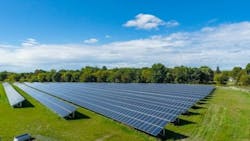EDF Renewables Receives Approval for 49.9 MW Tye Lane Solar Farm in the United Kingdom
EDF Renewables UK received planning consent from the Mid Suffolk District Council’s planning committee for the company’s latest project, the 49.9 MW Tye Lane Solar Farm, which will be located on Tye Lane, northwest of Bramford, to help ease growing concerns surrounding climate change and energy security in the UK.
Once complete, the Tye Lane Solar Farm is projected to produce approximately 67,500 MWh annually – the equivalent of powering more than 14,500 homes each year – while saving nearly 17,100 tons of carbon dioxide emissions per year.
“We are very pleased to receive planning consent for Tye Lane, which is a great site for solar. EDF Renewables UK… [is] firmly committed to solar as a technology which will help us accelerate a net zero future where clean energy powers all our lives,” said Darren Cuming, Head of Development at EDF Renewables UK.
Construction is slated to begin in 2024, and the entire process is estimated to take six to nine months to complete. Once active, the clean energy produced by the solar farm throughout its 35-year lifetime will be transported via grid connection routes directly to the Bramford substation.
About the Author
EnergyTech Staff
Rod Walton is senior editor for EnergyTech.com. He has spent 17 years covering the energy industry as a newspaper and trade journalist.
Walton formerly was energy writer and business editor at the Tulsa World. Later, he spent six years covering the electricity power sector for Pennwell and Clarion Events. He joined Endeavor and EnergyTech in November 2021.
He can be reached at [email protected].
EnergyTech is focused on the mission critical and large-scale energy users and their sustainability and resiliency goals. These include the commercial and industrial sectors, as well as the military, universities, data centers and microgrids.
Many large-scale energy users such as Fortune 500 companies, and mission-critical users such as military bases, universities, healthcare facilities, public safety and data centers, shifting their energy priorities to reach net-zero carbon goals within the coming decades. These include plans for renewable energy power purchase agreements, but also on-site resiliency projects such as microgrids, combined heat and power, rooftop solar, energy storage, digitalization and building efficiency upgrades.
